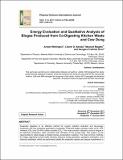| dc.description.abstract | Anaerobic digestion is an effective method for organic pollution reduction and bio-energy production and has increasing applications worldwide. Produced biogas consists mainly of 50–70% methane (CH4) and 30–50% carbon dioxide (CO2). The most common utilization route of biogas is for electricity production, often combined with utilization of the excess heat. This widens up the opportunities to utilize biogas in distant energy consumption locations. The most common methods for biogas upgrading include water washing, pressure swing adsorption, polyglycol adsorption, and chemical treatment, which are performed outside the anaerobic reactor and require investments in external compressors, pumps, membranes, etc. Therefore, the cost for biogas upgrading is relatively high. In situ biogas upgrading has been investigated previously and several methods have been proposed, where CH4 rich biogas could be obtained directly from the anaerobic reactor. In this research, we investigated the energy evaluation and qualitative analysis of biogas produced from co-digesting kitchen waste and cow dung. Biomass Kitchen waste was collected, as feedstock for a home-made laboratory-scale anaerobic digester (10L capacity) to produce biogas in the Masinde Muliro University of Science and Technology (MMUST) Physics laboratory for 27 days. This was done at a temperature range of 25°C - 35°C and in an alkaline environment maintained by adding a medium of sodium hydroxide. The power potential for the biogas collected was found to be 22,461.77 W/m3. Comparing this with the Literature value of 37,258.9 W/m3 for pure methane, it was found that 60.29% of the biogas sample tested was methane. The gas chromatogram on five gas samples collected from individual kitchen waste substrates showed slightly higher percentages of methane content in the biogas collected from starch and pure cow dung in relation with other tested samples. Biogas production significantly increased when co-digestion of kitchen waste was done with cow dung. An even higher biogas yield was realized in the samples maintained in alkaline environment. This study forms a basis upon which large scale biogas production from kitchen waste can be done for domestic and commercial use. | en_US |

